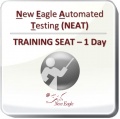Raptor-Test-FAQ: Difference between revisions
| Line 40: | Line 40: | ||
|} | |} | ||
======RAPTOR | ======RAPTOR TOOL TRAINING ON-SITE====== | ||
{|class="wikitable" cellpadding = "5" | {|class="wikitable" cellpadding = "5" | ||
| Line 48: | Line 48: | ||
|- | |- | ||
|style = "width: 35%"| | |style = "width: 35%"| | ||
RAP-TRAINING-02 | |||
|style = "width: 35%"| | |style = "width: 35%"| | ||
<gallery>File:NEAT-TRAINING-02.jpg</gallery> | <gallery>File:NEAT-TRAINING-02.jpg</gallery> | ||
|style = "width: 35%"| | |style = "width: 35%"| | ||
[ | [https://store.neweagle.net/product/raptor-tool-onsite-training/ RAP-TRAINING-02] | ||
|} | |} | ||
Latest revision as of 12:18, 1 June 2018
New Eagle > Products Wiki > Raptor Platform > Raptor-Test > Raptor-Test FAQ
What is required in order to test an application?
The AT setup configuration can vary depending on the application's testing requirements. For some applications, the only required test components are: a PC to run Raptor-Test, a Kvaser cable for CAN-to-USB connection, and the Test Module. For other applications, Raptor-Test can interface with both a Test Module and a Coordinator Module via CAN to enable simulation of larger and more complex systems.
What is SimHIL?
SimHIL or Simulated Hardware-in-the-Loop testing is a control systems validation strategy using simulated I/O to verify that the software functions match the application requirements. The goal of using a SimHIL approach is to validate software on the production hardware with physical signals to stimulate the module. Simulated I/O can include both CAN transmit and receive as well as analog/discrete inputs and outputs. So it is similar to hardware in the loop testing but 'the hardware components' are replaced by simulated models and controllers. This strategy of testing offers numerous advantages.
Does New Eagle build and sell automated test benches?
Yes, we would be happy to help you get started in using Raptor-Test effectively. Here is an Automated Testing bench designed and built for a customer. It includes a Module Under Test, a Coordinator Module, and a CAN-to-Analog Module for simulated Hardware-in-the-Loop testing. This bench enables the verification of the specific requirements of the customer's application.
Please Contact Sales for more information.
What license options are available for Raptor-Test?
Customers can choose to purchase either a node-locked or dongle-based version of the Raptor-Test software. A dongle is a small USB device the contains the software license. The advantage of a USB dongle is that the software license can easily be passed from one computer to another. A node-locked license, on the other hand, lives on the computer itself and eliminates the need for any external licensing hardware. Node-locked licenses cannot be lost or come lost, which can be problematic for USB license dongles. While node-locked licenses can be transferred from one computer to another, the process is not as simple and fast as removing a USB dongle from one computer and plugging it in to another computer.
After purchasing Raptor-Test will I get updates on the latest features?
Yes, customers have access to the latest software releases for a period of one year after their purchase. Each software release adds new features and address bug fixes. If customers wish to maintain access to new software releases after their first year of using the product, they can purchase a software maintenance license. Software maintenance licenses are valid for 1 year and can be renewed in perpetuity.
Does New Eagle provide training for Raptor-Test?
Yes, training is available both on-site or we can come to you. For more information see below:
RAPTOR TOOL TRAINING SEAT
| Part Number | Picture | Visit our Webstore |
|---|---|---|
|
RAP-TRAINING-01 |
|
RAPTOR TOOL TRAINING ON-SITE
| Part Number | Picture | Visit our Webstore |
|---|---|---|
|
RAP-TRAINING-02 |
|


